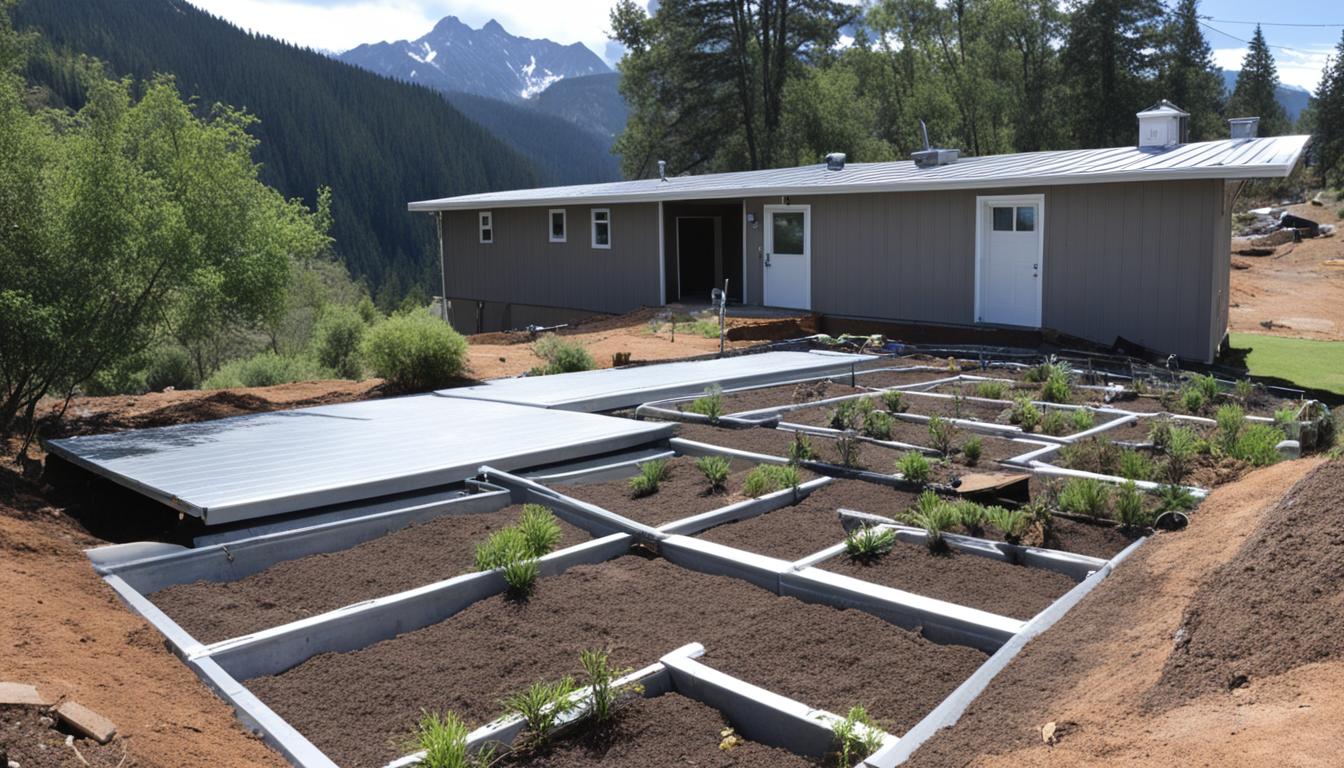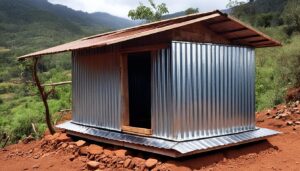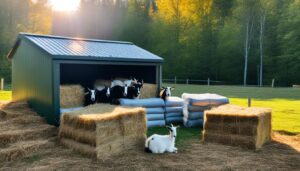As a pygmy goat owner, I’ve learned keeping their living space dry is key. Making sure water doesn’t build up near their house matters a lot. This not only makes them happier but also healthier. I’m thrilled to pass on the tips I’ve picked up to make a great drainage system for pygmy goats.
Are you setting up a new place for them or improving what you already have? This guide will help you make a good drainage system. It will stop the area from getting too muddy, help with keeping their hooves in good shape, and make your goats happier and more active. We owe it to these small goats to create the ultimate home for them.
Let’s start looking at the important steps for right drainage around your pygmy goat house. With some effort, you can have a place that’s always dry and welcoming for your goats. You’ll see how much they thrive in this kind of environment.
Key Takeaways
- Proper drainage is essential for maintaining a dry and healthy environment for your pygmy goats.
- Effective drainage can prevent muddy conditions, promote hoof health, and improve overall hygiene.
- Careful site selection, grading, and the implementation of surface and subsurface drainage solutions are key to designing an effective drainage system.
- Regular maintenance and monitoring of the drainage system are crucial to ensure its long-term performance.
- Improved health, comfort, and productivity are the key benefits of proper drainage around a pygmy goat house.
Importance of Proper Drainage
Proper drainage is key to keeping your pygmy goats’ area dry and healthy. If water piles up near their house, you might get a lot of mud. This mud makes it easier for goats to get sick or hurt their hooves. A drainage system stops water from collecting, which keeps the ground nice and solid. This way, you prevent bacteria and bugs from living in the wet ground. Your goats will live in a safe, clean space thanks to this drainage.
Preventing Muddy Conditions
Drainage is a must to avoid mud around your pygmy goat house. Without good drainage, water stays on the ground, making everything muddy. This mud can cause many health problems for the goats, especially their hooves. Good drainage ensures the area stays dry and firm. With no mud, your goats have a much better place to live.
Promoting Hoof Health
Dry and well-drained areas are vital for your pygmy goats’ hoof health. If their home is muddy and wet, they might get sick hooves. A well-planned drainage system cuts down on wetness, keeping the ground good for hooves. This helps your goats have strong, healthy hooves and less foot trouble.
Site Selection and Preparation
Choosing a good spot for your pygmy goat house is critical. Look for a place that naturally drains well or can be made to drain better. This will help keep the area around the house dry and less muddy.
Steer clear of areas that are low, have bad soil, or collect water easily. These spots tend to get muddy. Find a location on higher ground or with a slight slope. This way, water will run away from the goat house naturally. It’s important to think about the land’s shape and soil to make a cozy home for your goats.
Choosing the Right Location
Is your chosen spot not sloped? You’ll need to work the ground to drain water away. Using big machines, create a gentle slope away from the building. This lets water flow away and not stay near the house.
The slope should be 1% to 2%. This is enough for water to drain without being too steep. Properly grading the ground is crucial for a dry and safe goat area.

Drainage Systems for Pygmy Goat Housing
To make sure there’s proper drainage around a pygmy goat house, using surface drainage is key. This means placing swales, ditches, or French drains strategically to move rainwater away. Swales are like little, shallow slopes that can guide water.
Ditches are deeper and direct more water flow. French drains, made of pipes in gravel, handle water beneath the surface. The best method depends on how much water is coming and the area’s layout.
Subsurface Drainage Options
Along with the above, subsurface drainage can be a good choice to handle water under a pygmy goat house. This involves putting pipes or drain tiles in the ground, usually 12 to 24 inches below. They help take out extra groundwater, stopping it from collecting around the house.
The design and place of these subsurface drainage parts change based on the soil, water depth, and how the goat area is set up.
How do I ensure proper drainage around a pygmy goat house?
Ensuring good drainage around a pygmy goat house is key for a healthy and comfy space for your goats. Here are some important steps to take:
- Site Selection and Preparation: Pick a spot with slight slopes or high ground. This lets water naturally flow away from the pygmy goat house. Make sure the ground slopes gently (1-2%) to move extra water away.
- Surface Drainage Solutions: Use features like swales, ditches, or French drains to catch and guide surface water. These aids keep the goat shelter rainwater in check and stop puddles near the pygmy goat barn.
- Subsurface Drainage: Think about adding pipes or drain tiles underground. These remove extra water and boost the overall small ruminant shelter drainage.
- Landscaping and Vegetation: Work with the natural slopes. Plant deep-rooted, water-loving plants rightly. This helps firm the soil and makes the pygmy goat housing site preparation better.
- Maintenance and Monitoring: Keep the drains clean. Check them often for problems. This keeps your drainage working well.
By following these steps, you can handle how do I ensure proper drainage around a pygmy goat house well. This gives your pygmy goat herd a dry, healthy, and comfy place to live.

Dealing with Excess Rainwater
To manage too much rainwater around a pygmy goat house, use smart techniques. Place gutters, downspouts, and splash blocks carefully to move water away. Gutters along the roof gather rainwater. Downspouts then push the water to a safe place, keeping the goat house area dry.
Splash blocks, at downspouts’ ends, spread out the water flow. This stops soil damage by preventing erosion. By using these methods, the area around the pygmy goat pen stays dry and well-drained.
Diversion Techniques
There are more ways to manage extra rainwater near a pygmy goat house. You can use rain gardens, dry wells, or big holes to soak and release water. Rain gardens are special spots, planted with local plants, that soak up and clean the water. Dry wells and trenches help slowly add the water back into the soil.
Adding these ways of managing water can stop the ground from getting too wet. It helps handle heavy rains in a better way near the pygmy goat pen, keeping the area from flooding.

Water Management Strategies
Combine diversion tactics and water management strategies to tackle rainwater problems around a pygmy goat house. This full plan keeps your goats’ living space dry and well-kept. It helps your herd stay healthy, happy, and productive.
Flooring Considerations
For a pygmy goat house, dirt floors are great. They offer good traction and soak up water well. This reduces wetness and mud. Goats stay dry and comfy. Dirt floors also provide better grip, lowering slip dangers, especially for young and old goats. To keep dirt floors working well, remove waste and add fresh soil often.
Elevated Platforms and Dry Areas
Elevated platforms and dry spots are key in a goat house. They make the space more comfortable and help with water drainage. Platforms raise the goats off the wet ground and let water flow away. They use the land’s slope to avoid standing water under the goats.
Creating dry areas with soft, absorbent materials is also smart. They give goats a clean, dry place to rest. It’s good for their health and they like it.

Surrounding Landscape and Vegetation
Designing a good drainage system for a pygmy goat house means looking at the land. We can work with the natural slopes and features to help water drain well. Placing the building on a sloped area aids in natural water flow without a lot of digging.
It’s also smart to keep natural ditches and paths that water naturally follows. This lets water be directed away from the goat house. Doing this means we need less man-made systems to control water.
Utilizing Natural Slopes
Putting the goat house on a sloping site helps water flow away easily. This way, we won’t need to level the land as much. Keeping natural water paths clear and using them wisely can cut down on work needed.
Strategic Planting for Drainage
Plants around the pygmy goat house can help in drainage. Choosing plants that love water and have deep roots stabilizes the land. They soak up extra water, easing the burden on our drainage setup.
Roots also keep the ground solid, stopping it from getting too muddy. Planning the right plants around the goat house makes the most of this natural help. This supports a great drainage system for the land.

Maintenance and Monitoring
Keeping the drainage clean around a pygmy goat house is key for it to work well for a long time. It’s important to clean it often and remove any trash. Check and clean any spots like swales or ditches where water might not flow well. Look for wet or muddy areas near the house. To avoid water buildup, keep an eye out for problems and fix them early. This will keep the water flowing smoothly around the pygmy goat house.
Inspecting Drainage Systems
Looking at the drainage systems near a pygmy goat house is crucial. This helps spot and fix any problems early. Make sure water flows well in areas like swales and ditches. Look for any wet patches on the ground, which might mean an issue with pipes under the ground. Fixing problems quickly, like repairing pipes or clearing debris, is important. It helps the drainage work well and keeps the area dry for your pygmy goats.
Benefits of Proper Drainage
A well-designed pygmy goat housing drainage system is key for a healthy herd. It keeps the ground dry, reducing the risk of hoof and skin issues. This method also cuts down on diseases and parasites that like damp areas. Healthy goats mean happier goats, which also means they are more productive.
Improved Health and Hygiene
Good drainage makes a small ruminant shelter a better place to live. A dry living area lets goats move and play easily. It also decreases stress and improves their health. This leads to better growth, reproduction, and milk production. By maintaining proper ground sloping, you create a space that meets your goats’ needs. This will enhance their productivity and success.
Increased Comfort and Productivity
A solid pygmy goat pen drainage system offers many benefits. It improves health, hygiene, and comfort for your goats. Having a good drainage plan is vital for their well-being.

Common Drainage Problems and Solutions
Even with a good drainage system, issues can still pop up near a pygmy goat housing. Debris, like leaves, twigs, and animal waste, often blocks the water flow. This blockage can happen in the small ruminant shelter drainage too.
Having lower areas or depressions where water gathers is another common problem. This happens when the ground settles or is not sloped correctly. These are the main reasons for pygmy goat pen drainage system not working well.
- To fix clogs, check and clean the drainage parts often. Doing this helps water flow freely and stops excess moisture near the pygmy goat shelter.
- For low-lying spots, add more fill or soil to make the ground higher there. This improves the slope and drainage, keeping the area around your pygmy goats dry.
Being on the lookout for these drainage issues and dealing with them quickly is key. It keeps your pygmy goat housing in good shape. This way, your goats have a safe and dry home.

Conclusion
Setting up good drainage around a pygmy goat house is key. It keeps the area dry and healthy. This way, your goats stay comfortable. Picking the right location and using the right drainage methods is crucial. Also, adding some landscaping helps with water control. Make sure to keep an eye on the system. Regular checks and fixes will keep it working well.
Good drainage around a pygmy goat house is vital. It helps their home stay in top condition. Designing and keeping up a good drainage system is important. It makes sure my small ruminant shelter is a great place for goats to live. This also helps my goat business do well.
With the right plan and care, managing proper drainage around a pygmy goat house is doable. Focusing on good drainage means my pygmy goats have a great home. A dry and clean space keeps them healthy. It also gives me peace of mind as a goat owner who cares.
FAQ
How do I ensure proper drainage around a pygmy goat house?
Keeping a pygmy goat house dry is key for their health. You should pick a spot that naturally drains well. It’s good if the area slopes gently. This helps water flow away. Adding drainage like swales, ditches, and French drains is also smart.
Using gutters, downspouts, and splash blocks helps with rainwater. Rain gardens and trenches can manage water too. Inside, choose dirt floors, raised areas, or dry spots. Use plants to assist drainage and keep an eye on your system often.
Why is proper drainage around a pygmy goat house important?
Good drainage keeps your pygmy goats healthy and happy. It stops the area from getting muddy. This mud could cause hoof issues and make your goats sick. An area that’s dry and well-drained supports their well-being and productivity. It also helps prevent disease spread.
How do I choose the right location for a pygmy goat house?
Choose a spot for your pygmy goat house that’s not low or soggy. A higher area or gently sloping land is better. This keeps the area from getting flooded and muddy. It also helps water move away from the house naturally.
What are some surface drainage solutions for a pygmy goat house?
Surface drainage is key for a dry pygmy goat house. Use swales, ditches, or French drains. Swales and ditches guide water away. French drains, with pipes and gravel, help with deeper water movement.
How can I incorporate subsurface drainage into my pygmy goat housing?
Besides surface solutions, add drains under the ground. Place perforated pipes or drain tiles 12 to 24 inches deep. This subsurface system removes excess water that might gather around your goats’ home.
What are the benefits of proper drainage around a pygmy goat house?
Good drainage means better health and less disease for your goats. It also makes them more comfortable and productive. A dry living space supports their needs, helping them grow well and produce more milk.
What are some common drainage problems around a pygmy goat house?
Even with a good drainage plan, issues can happen. Drainage parts might get clogged. Water can stand if the area is not sloped right. Erosion, not enough capacity, and poor placement can also be problems. Regular cleaning and checking can help avoid these issues.



